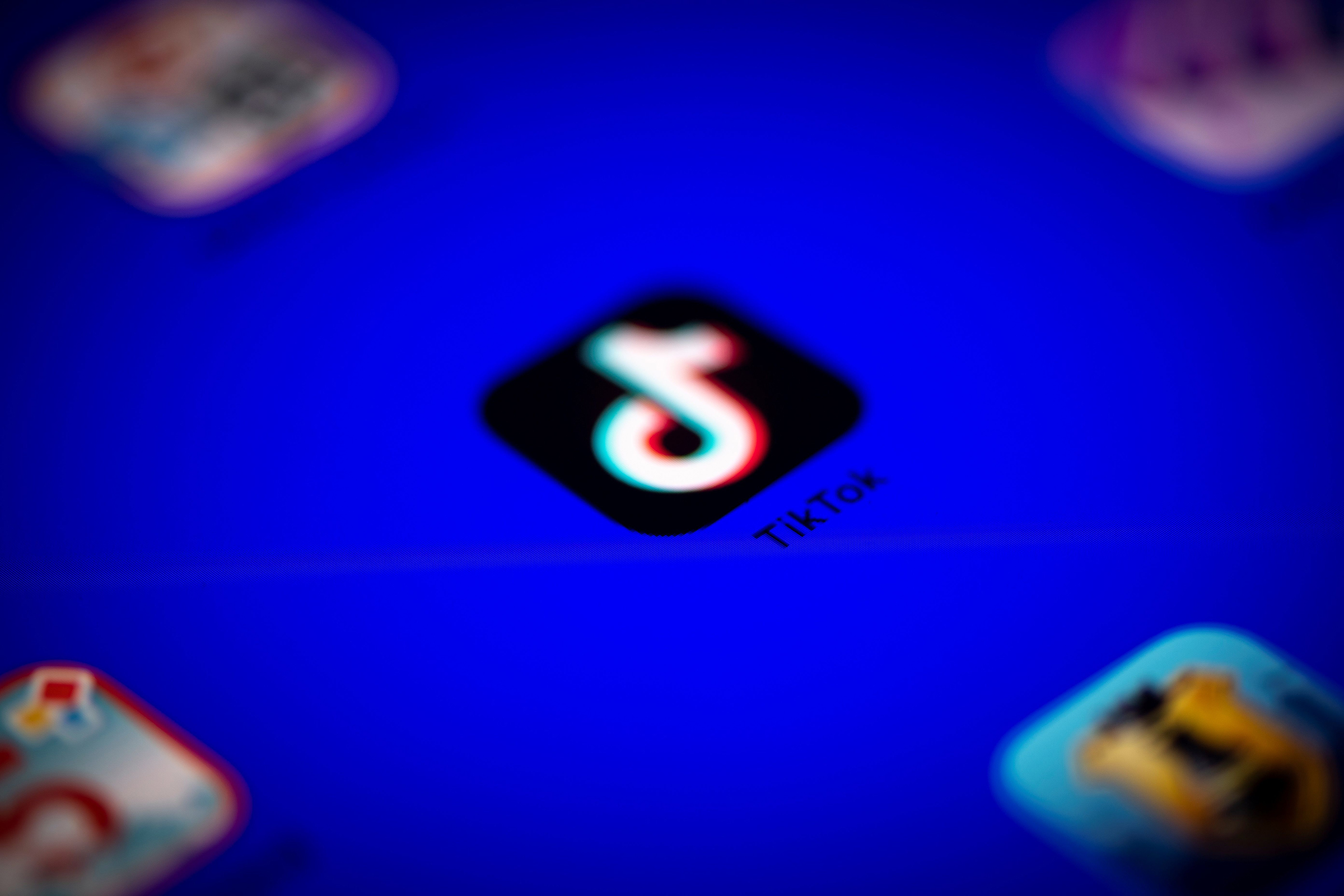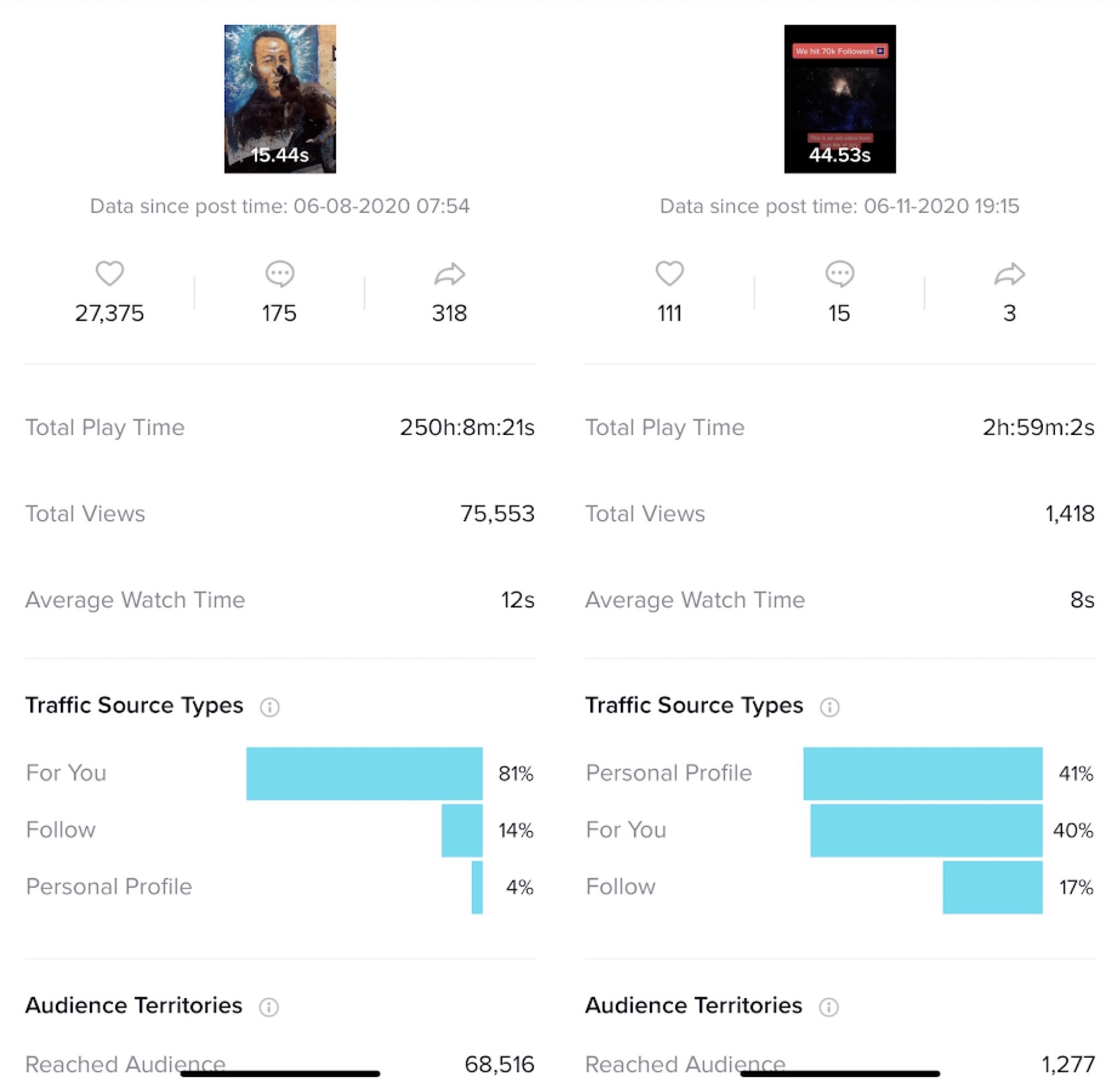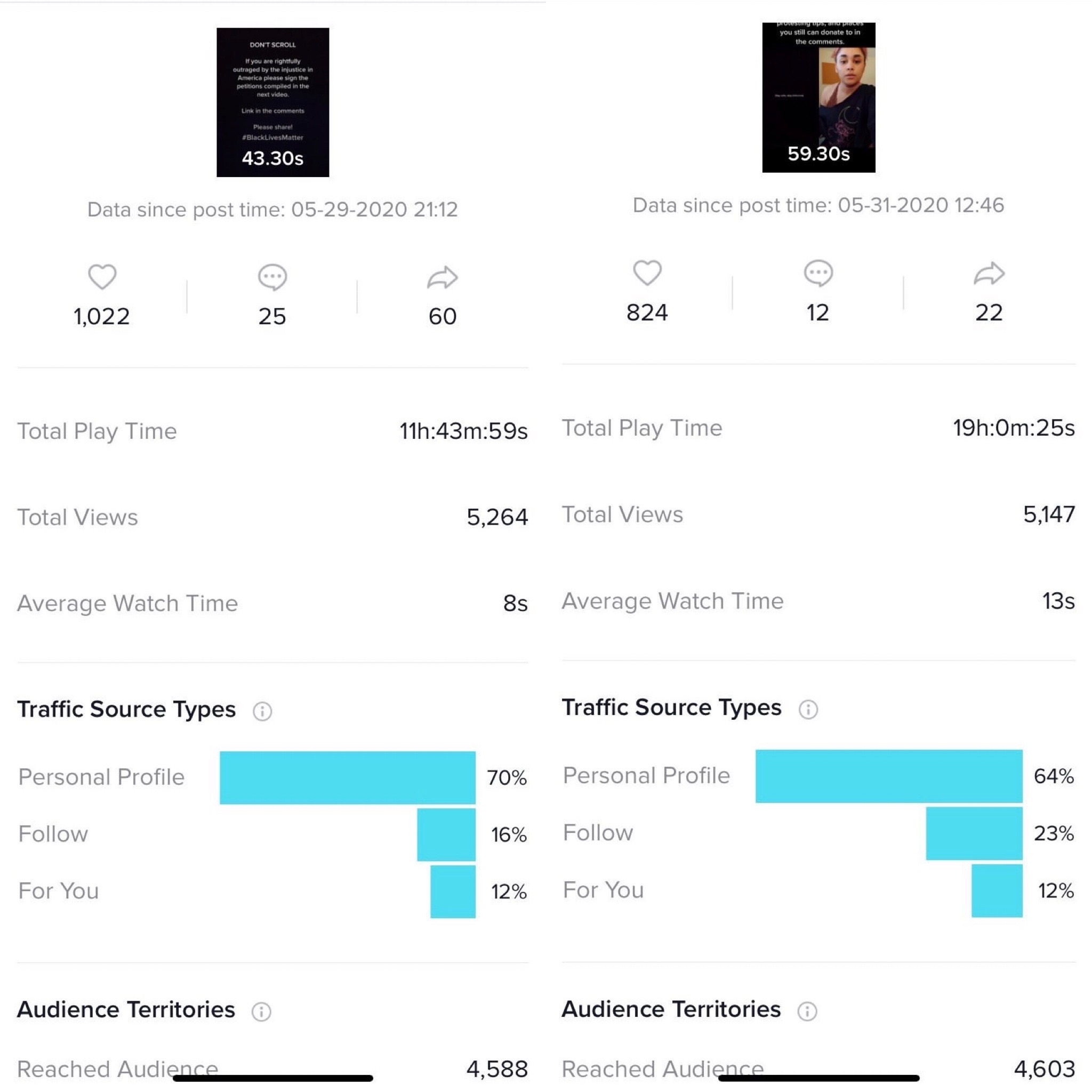
Videos being taken down, muted or hidden from followers: These are all issues that some TikTok creators say they’re facing for posting Black Lives Matter content.
In the wake of releasing a statement in June apologizing to members of its Black community who have felt unsafe, unsupported, or suppressed, TikTok continues to face bias allegations from Black creators and others posting Black Lives Matter content. This issue has become prevalent as TikTok, the most downloaded non-gaming app worldwide in 2020, has transformed into a hub for activism as the year has progressed.
A number of creators who TIME spoke to say they have either experienced noticeable declines in viewership and engagement on their videos after posting content in support of the Black Lives Matter movement or noticed recent instances where they felt that TikTok’s community guidelines weren’t being fairly applied to Black creators. Even on the heels of TikTok’s pledge to effect positive change for its Black creators, some users say they’re still seeing similar patterns of unequal treatment play out on the platform. When asked to address the claims of sources in this story, Kudzi Chikumbu, the Director of Creator Community of TikTok U.S., tells TIME that TikTok “unequivocally” does not engage in shadow banning, an umbrella term under which these types of discrimination claims often fall.
Referring to the alleged practice of limiting the spread of content without notifying creators that it violates any community guidelines, shadow banning has become an increasingly widespread concern among users on not only TikTok, but also Twitter and Instagram. Due to the nature of the concept of shadow banning, it’s difficult to substantiate whether it is or isn’t happening. Some point toward the bias in the habits of active users as the most influential indicator of what content users see rather than intentional direct racism. However, TikTok’s rise in popularity amid coronavirus coupled with assertions that it’s been censoring videos by people of color, and specifically, Black creators, have brought the question of whether the app supports its Black creators to the forefront.
Following the May 19 Black Out movement organized by Lex Scott, the founder of Black Lives Matter Utah, that called on TikTok users to stand in solidarity against censorship of and racism against Black creators, TikTok came under fire for what it said was a “technical glitch” that affected the view count displays on videos tagged with the hashtags #BlackLivesMatter and #GeorgeFloyd even though those hashtags had garnered upwards of 1 billion views as protest content skyrocketed. After the issue was flagged by a Twitter user on May 28, TikTok released a statement on Twitter on May 29 saying that the glitch was also affecting random words like #hello and #cat before resolving the problem that same day. This incident took place as Black Lives Matter activism was surging on a number of social media platforms in response to a global uprising against police brutality and racism in the U.S., drawing a powerful level of attention to it.
TikTok and ByteDance, the Chinese company that owns TikTok, are far from the only apps on which users have logged complaints about apparent bias. But while glitches on platforms as big as TikTok aren’t uncommon, with a July 9 issue that caused likes and views on TikToks to temporarily disappear — it was resolved that same day — fueling unsubstantiated speculation that the app was shutting down in the U.S., some TikTokers who TIME spoke to say the hashtag issue was simply the final straw in terms of their view of TikTok’s treatment of Black creators.
“When someone says something and they have a clear pattern of behavior that shows that something else might be the case, then you can’t ignore that,” Chinyelu Mwaafrika (@chinforshort), a 20-year-old TikToker from Indianapolis who shares both comedic and social justice-related content, says. “TikTok as an app is not friendly to Black creators. Whether that’s because of the way that it’s programmed or because of the way that users interact and engage with content, it’s not an app that you see a lot of Black creators getting hugely successful on.”
Although some users say they have still been experiencing issues since, in its June 1 apology, the company pledged to better support its Black community and take steps toward a more inclusive environment. Platforms like Instagram and YouTube have also been known to tweak their algorithms in ways that affect engagement for existing creators, so it’s not unprecedented in the early history of social media platforms. “To our Black community: We want you to know that we hear you and we care about your experiences on TikTok,” TikTok U.S. General Manager Vanessa Pappas and Chikumbu said in the statement. “We welcome the voices of the Black community wholeheartedly.”
TikTok has previously admitted to suppressing posts from physically disabled, LGBTQ and overweight users as part of what it said was a set of what was intended to be “anti-bullying” policies, raising questions for some users about what they see and what gets filtered by TikTok’s algorithm — which uses a number of factors, including likes, shares and accounts followed, to predict what users will be interested in seeing on their For You feeds.
Low view counts
After documenting some of his experiences at Black Lives Matter protests in Los Angeles on TikTok in early June, 19-year-old Kam Kurosaki (@kamkurosaki), who went viral in May for sharing a video of his dad dancing to Ariana Grande, says that despite having over 80,000 followers, the views on his videos began dropping into the low thousands. “I was out protesting and sharing [videos] and when I went back to my normal content, I saw that my videos went from getting thousands if not hundreds of thousands of views to barely getting 1,000,” he says. “With that being the direct next event after my Black Lives Matter posts, it was kind of hard to see it as anything but shadow banning.”

The breakdown of how users view certain videos also plays a role in the issue of content exposure, says 19-year-old Onani Banda (@thedopestzambian). When creators look at their video analytics, they can see what percent of a post’s views came from users watching it on their For You page, followers seeing it on their Following feed, or people going to their personal profile and clicking on it directly from there.

Banda says that after two videos in which she spoke about supporting the Black Lives Matter movement garnered a much lower view count (less than 6,000 to date) than she expected from over 100,000 followers, she discovered that the majority of the views they did get came from Personal Profile clicks. “I still have those two videos up and they’re some of the least viewed on my account,” she says. “I’ve never privated them [hidden them from view], but 60-70% of their views come from Personal Profile, meaning users would have to actively seek them out to see them. My followers are not seeing them.”
For You feeds and community guideline violations
On June 8, TikTok detailed how its recommendation system surfaces videos in the For You feed, addressing how it’s working to protect against engagement biases that may currently affect the system. “Developing and maintaining TikTok’s recommendation system is a continuous process,” Pappas and Chikumbu said in the statement.
But, noting that to this day she feels the number of views her videos get generally doesn’t square with her follower count, a lack of content by Black creators appearing on her For You page was just one of the issues with TikTok that 25-year-old Emily Barbour (@emuhhhleebee) spoke about in a May 20 video that she says she posted because she felt like she was shadow banned.
“I very vividly remember the week of the May 19 Black Out, I had so much engagement and I had gained like 65,000 followers,” she says. “And then the very next day nobody was seeing any of my posts. I made a post and it sat on my profile for about three hours before anybody even saw it. That’s when I actually made a post asking if anybody else felt like they were shadow banned. That was the first time where it was blatant.”
Issues with Tiktok’s community guidelines have also dogged Barbour since joining the app, she says. After seeing a video in early July in which another creator appeared in blackface, she screen recorded it to share with her followers before reporting the post for hate speech. She also reported another video made by the same user saying it was “incredibly racist.”
However, she says that while the video she made with the screen recording was quickly muted for violating copyright guidelines, after reviewing her report, TikTok ruled that neither of the other user’s videos violated its community guidelines. “My followers reported back in the comments saying they went to report the videos and within minutes were met with the same ‘does not violate community guidelines’ messages,” she says. “Both were up for over two days before [being taken down], even with thousands of people reporting them before I saw them.”
It’s experiences like that, Barbour says, that have contributed to her negative feelings about TikTok. “I feel like this not only shows the unfair treatment that Black creators face on the app, even when trying to make it safer for others, but also showcases the racial bias that exists on TikTok,” she says.
Moderating videos is one of the issues the company is now working to address, Chikumbu says. “Some of the work that we’re doing for the Black community to make sure they feel supported is that we’re investing in our technology and moderation strategies to better handle potentially violative content and design a little more user-friendly appeals process,” he says.
“Bias in the user base”
For Jailyn Feliz (@jailynisfeliz), a 20-year-old TikToker from Charlotte, N.C., the experience she’s had with TikTok’s algorithm feels like another chapter in the history of the suppression of Black voices at a time when the issues of race and policing in America are a national conversation. “The history of people being silenced is ongoing,” she says. “The fact that it’s kind of taken on a new form isn’t surprising, but it’s upsetting. We’re trying to make change and continue to get people to notice what’s wrong. You can work against the algorithm if you push with comments and liking and sharing so we have to lift each other up because who else will.”
While how the recommendation system works can play a role, Mwaafrika says that he thinks that some of these issues are the result of the demographics of TikTok’s users. “I think there’s definitely a conversation to be had about bias in the user base,” he says. “It’s an app that’s dominated by white people and of course you’re going to like the content of people you can relate to. I think that, along with the algorithm suppressing content from Black creators, it’s also worth talking about the fact that a lot of white users on this app don’t support Black creators.”
Collaborating with users of diverse backgrounds is one measure TikTok has undertaken in response to the questions of bias that have been raised about the platform. After expressing some of her personal concerns about success for Black TikTok creators, 26-year-old Bria Jones (@HeyBriaJones), who posts a variety of lifestyle videos, says that she began working with the company to help remedy inclusivity issues.
“While the concerns of many Black creators are valid, I think the issue with Black creators is much deeper than the algorithm,” she says. “Similar to the real world, the internet is not a level playing field. TikTok recognizes these gaps and is actively working to make the app more inclusive and is working with Black creators like myself to get there. It will take work and we are not there yet, but we are moving towards that and I am happy that TikTok invited me to hold them accountable.”
Considering how TikTok popularity can open the door to a slew of other opportunities — as it has for white TikTok stars like Charli D’Amelio, Loren Gray and Addison Rae — 20-year-old Raisha Doumbia (@pastramionrai) says that Black creators need to start getting the recognition they deserve. “A lot of times when you get successful on TikTok, there are multiple opportunities and other businesses want to work with you,” she says. “[Businesses] can’t find those people if they’re being shadow banned.”
Doumbia says that one of the times she noticed a decline in views was after posting a video in early June about Iyanna Dior, a Black transgender woman, being attacked by a mob in Minneapolis. “I have 100,000 followers, but some of my videos only get like 800 [views] and people will tell me that they didn’t get to see them even though they follow me,” she says. “A lot of times my views don’t match up to my followers. It just doesn’t make sense.”
“We don’t really have anywhere else to go”
Ensuring that fellow Black creators know that they’re not alone is one of the main reasons 17-year-old Joshua Teshome (@surelyjosh) says that he feels it’s important to speak out about alleged instances of bias. “[TikTok is] literally the easiest app to get big on, and we want to have as fair a chance as the white creators do,” he says. “We just want to be equal.”
Ultimately, the creators who TIME spoke to are hopeful that things will improve on TikTok and want to continue using the app for the audience. “The way things are now, I’m definitely unhappy about it and I’m definitely not going to stop talking about it. But I like creating content and TikTok is the only place where I have any sort of real following,” Mwaafrika says. “We know TikTok isn’t really the best place to be if you want people to see your content as a Black creator, but we don’t really have anywhere else to go.”
For users who want to show support, Mwaafrika says that it’s time to assess what compels people to like certain videos and not others. “I know I’m definitely motivated by biases when I like things,” he says. “I like seeing Black creators on my For You page, so I tend to like more Black creators. So I think that if you do see a Black creator on your For You page, even if you don’t find [their video] particularly funny, someone else might, and might not see it without the attention you’re giving them. I think it’s important for everyone to look out for one another.”
More Must-Reads from TIME
- Cybersecurity Experts Are Sounding the Alarm on DOGE
- Meet the 2025 Women of the Year
- The Harsh Truth About Disability Inclusion
- Why Do More Young Adults Have Cancer?
- Colman Domingo Leads With Radical Love
- How to Get Better at Doing Things Alone
- Michelle Zauner Stares Down the Darkness
Write to Megan McCluskey at megan.mccluskey@time.com